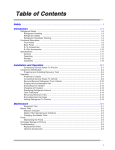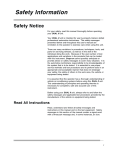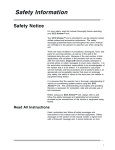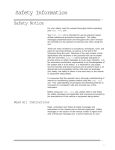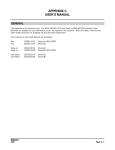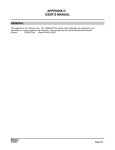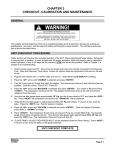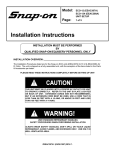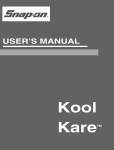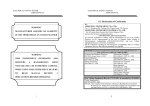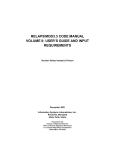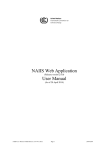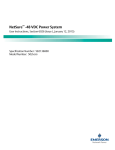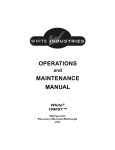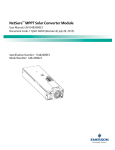Download Table of Contents - Snap
Transcript
Table of Contents Safety .................................................................................................................... I Introduction ...................................................................................................... 1-1 Refrigerant Gases .................................................................................................................... 1-2 Refrigerant Handling .................................................................................................... 1-3 Refrigerant Safety ...................................................................................................... 1-3 Refrigerant Substitute Warning .................................................................................... 1-4 Functional Description .............................................................................................................. 1-5 Typical Front View ...................................................................................................... 1-5 R-12 Accessories ........................................................................................................ 1-8 R-134a Accessories .................................................................................................... 1-9 Specifications .......................................................................................................................... 1-10 General .................................................................................................................... 1-10 Operating .................................................................................................................. 1-10 Storage ...................................................................................................................... 1-11 Capacities .................................................................................................................. 1-11 Installation and Operation ................................................................................ 2-1 Connecting Service Hoses To Dual 3412 .................................................................... 2-1 Component Identification .......................................................................................................... 2-2 Preparing and Installing Recovery Tank ...................................................................... 2-3 Operation .................................................................................................................................. 2-6 Preliminary Checks ...................................................................................................... 2-7 Connecting Service Hoses To Vehicle .......................................................................... 2-9 Recover/Recycle Refrigerant From Vehicle ................................................................ 2-10 Purging Non-condensable Gas .................................................................................. 2-11 Evacuating A/C System ............................................................................................ 2-12 Charging A/C System ................................................................................................ 2-13 Displaying Refrigerant Amount .................................................................................. 2-14 Tank Full/Empty ........................................................................................................ 2-14 Removing Recovery Tank .......................................................................................... 2-14 Evacuating Service Hoses ........................................................................................ 2-14 Adding Refrigerant To Dual 3412 .............................................................................. 2-15 Maintenance ...................................................................................................... 3-1 Equipment Tips .......................................................................................................... 3-1 Master Filter .............................................................................................................................. 3-2 Moisture Indicator ........................................................................................................ 3-2 Master Filter Maintenance Schedule - R12 .................................................................. 3-3 Master Filter Maintenance Schedule - R134a .............................................................. 3-5 Changing the Master Filter .......................................................................................... 3-6 Pump ........................................................................................................................................ 3-7 Maintaining the Pump .................................................................................................. 3-7 Prolonged Storage of Dual 3412 .............................................................................................. 3-9 Troubleshooting ...................................................................................................................... 3-10 Replacement Parts .................................................................................................... 3-11 Optional Accessories ................................................................................................ 3-11 i Table of Contents ii Table of Illustrations Introduction Figure Figure Figure Figure 1-1: 1-2: 1-3: 1-4: Typical Front View ................................................................................................ Typical Port Designation ........................................................................................ R-12 Accessories .................................................................................................. R-134a Accessories .............................................................................................. 1-5 1-7 1-8 1-9 Installation and Operation Figure 2-1: Service Hoses and Gauge Sets ............................................................................ 2-2 Figure 2-2: Recovery Tank and Temperature Probe ................................................................ 2-6 Figure 2-3: Service Hose Connections to Vehicle .................................................................... 2-9 Maintenance Figure 3-1: Moisture Indicator Chart ........................................................................................ 3-2 Figure 3-3: Master Filter .......................................................................................................... 3-6 Figure 3-4: Pump .................................................................................................................... 3-7 iii Trademark and Copyright information Trademark Acknowledgements Snap-on® is a trademark of Snap-on Technologies Incorporated. Sun® is a trademark of Snap-on Tools Company. Dual 3412 is a registered trademark of Snap-on Tools Co. Copyright Information Dual 3412 User’s Manual ©1996 Snap-on Incorporated. The information, specifications and illustrations in this manual are based on the latest information available at the time of printing. Sun reserves the right to make changes at any time without notice. iv Using this Manual This manual contains instructions for use and setup of the unit. A table of contents and table of illustrations are provided to make this manual easy to use. Some of the information shown in text or illustrations is obtained using optional equipment. A Snap-on/Sun Sales Representative can determine option availability. Conventions This section contains a list of conventions used in text. Service and Manifold Hand Valves References in text to opening and closing manifold hand valves assume: • Clockwise closes valves, and • Counterclockwise opens valves. References in text to opening and closing service hose valves assume: • Valve is open with lever parallel to hose, and • Valve is closed with lever perpendicular to hose. References in text to opening and closing 134a couplers assume: • Counterclockwise closes valves, and • Clockwise opens valves. Check Note A check note provides additional information about the subject in the preceding paragraph. Example: 3 For additional information refer to Chapter 2–Connecting Service Hoses to Dual 3412 Equipment Tips Equipment tips provide information that applies to specific equipment. Each tip is introduced by this icon p for easy identification. Example: pNever attempt to change the recovery tank during unit operation. For additional information refer to Chapter 2–Removing Recovery Tank. v Using this Manual Equipment Damage Situations arise during testing that could damage the vehicle or the test equipment. The word IMPORTANT signals these situations. Example: Failure to follow these instructions could damage compressor. Safety Messages Safety messages are provided to help prevent personal injury and equipment damage. All safety messages are introduced by a signal word indicating the hazard level. The types of safety messages are: Indicates an imminently hazardously situation which, if not avoided, will result in death or serious injury to the operator or to bystanders. Indicates a potential hazard which, if not avoided, could result in death or serious injury to the operator or to bystanders. Indicates a potential hazard which, if not avoided, may result in minor or moderate injury to the operator or to bystanders. Some safety messages contain visual symbols with signal words. Example: Engine systems can malfunction expelling fuel, oil vapors, hot steam, hot toxic exhaust gases, acid, refrigerant and other debris. Wear safety goggles and protective gloves, user and bystander. Engine systems that malfunction can cause injury. vi Using this Manual Terms Use the following definitions as a foundation to help understand Dual 3412 processes and/or components. Virgin Tank A refrigerant tank, disposable or refillable, that contains new refrigerant. When empty, disposable virgin tank must be evacuated and cannot be refilled. Dispose of evacuated tank in accordance with local, state and federal regulations that apply in your area. A refillable virgin tank should be returned to your supplier. Recovery Tank A refrigerant tank designed to store refrigerant recovered from a vehicle or transferred from a virgin tank. Recover The process of removing refrigerant from a system to prevent release of refrigerant into the atmosphere. On Dual 3412, this process is part of recycle. Recycle On Dual 3412, the process of removing refrigerant from a system, filtering, drying and storing it in the recovery tank. 3 Recycle is the only process that removes refrigerant. There is not a separate recovery process. 3 Dual 3412 is a single pass unit. This means refrigerant is filtered and dried before reaching the recovery tank. Once in the recovery tank, it is ready for reuse, after manual purging, if necessary. There is no separate "recycle" process to perform. Evacuate The process of drawing a vacuum on a refrigerant system to remove air and moisture. On Dual 3412, this process is known as vacuum. Charge The process of filling an air conditioning system with refrigerant. Purging The process of bleeding off non-condensable gases from the recovery tank. vii Using this Manual Stable Scale Situation where reading from refrigerant weight measuring device is steady. Moving Dual 3412 causes liquid refrigerant to slosh in recovery tank, resulting in unsteady scale reading. Avoid moving Dual 3412 before taking scale readings. viii Safety Information Safety Notice For your safety, read this manual thoroughly before operating Dual 3412. Dual 3412 is intended for use by properly trained, skilled professional automotive technicians. The safety messages presented below and throughout this user's manual are reminders to the operator to exercise care when using this unit. There are many variations in procedures, techniques, tools, and parts for servicing vehicles, as well as in the skill of the individual doing the work. Because of the vast number of test applications and variations in the products that can be tested with this instrument, Snap-on cannot possibly anticipate or provide advice or safety messages to cover every situation. It is the automotive technician's responsibility to be knowledgeable of the system that is to be tested. It is essential to use proper service methods and test procedures and to perform tests in an appropriate and acceptable manner that does not endanger your safety, the safety of others in the work area, or the vehicle or equipment being tested. It is assumed that the operator has a thorough understanding of vehicle air conditioning systems before using Dual 3412. This understanding of principles and operating theories is necessary for competent, safe and accurate use of this instrument. Before using Dual 3412, always refer to and follow safety messages and applicable test procedures provided by the manufacturer of the vehicle or equipment being tested. Read All Instructions Read, understand and follow all safety messages and instructions in this manual and on the test equipment. Safety messages in this section of the manual contain a signal word with a three-part message and, in some instances, an icon. I Safety Information The signal word indicates the level of hazard in a situation. • DANGER indicates an imminently hazardous situation which, if not avoided, will result in death or serious injury to the operator or bystanders. • WARNING indicates a potentially hazardous situation which, if not avoided, could result in death or serious injury to the operator or bystanders. • CAUTION indicates a potentially hazardous situation which, if not avoided, may result in moderate or minor injury to the operator or bystanders. Safety messages in this section contain three different type styles. • Normal type states the hazard. • Bold type states how to avoid the hazard. • Italic type states the possible consequences of not avoiding the hazard. An icon, when present, gives a graphical description of the potential hazard. IMPORTANT SAFETY INSTRUCTIONS Risk of suffocation. — Vehicle exhaust gases contain carbon monoxide. — Refrigerant gas can displace air in work area. Use Dual 3412 in locations with mechanical ventilation providing at least four air changes per hour. Suffocation will cause injury. Power Risk of electric shock and fire. • To avoid electric shock the power cord protective grounding conductor must be connected to a properly grounded AC outlet. • Use proper A.C. outlet for unit to operate correctly. See unit ID plate on back of unit. Extension cords are not recommended. If an extension cord must be used, use: — 16 AWG for cords up to 50', and — 14 AWG for cords greater than 50' but less than 100'. • Connect power cord to properly grounded outlet. Do not remove or bypass the grounding pin. Electric shock and fire can cause injury. II Safety Information Refrigerant Risk of expelling refrigerant under pressure. • Wear safety goggles and protective gloves, user and bystander. If any refrigerant gets into eyes, flush with water and seek a doctor's aid immediately, even though irritation may cease. • Do not remove master filter while under pressure. Perform maintenance procedure for removing master filter in Chapter 3–Changing the Master Filter. • Prevent refrigerant from contacting the skin. Expelled refrigerate can cause injury. Risk of explosion. • Do not use compressed shop air for leak detection or to pressure test a system containing refrigerant. Refrigerant can form combustible mixtures at pressures above atmospheric and with air concentrations greater than 60% by volume. • Do not heat a container of refrigerant above 125°F (52°C). Explosion can cause injury. Risk of fire. • Do not use this equipment in the vicinity of spilled or opened containers of gasoline. • Do not use Dual 3412 or leak detector equipment if R-12 substitutes are suspected. R-12 refrigerant substitutes may be flammable. Fire can cause injury. Risk of poison. • Avoid breathing air conditioning refrigerant and lubricant vapor or mist. • Do not allow refrigerant to contact open flame or be drawn into a running engine. This can cause refrigerant to become poisonous phosgene gas. • Use Dual 3412 to remove refrigerant from air conditioning systems. Exposure can irritate eyes, nose and throat. III Safety Information General Engine systems can malfunction expelling fuel, oil vapors, hot steam, hot toxic exhaust gases, acid, refrigerant and other debris. Wear safety goggles and protective gloves, user and bystander. Engine systems that malfunction can cause injury. Engine compartment contains electrical connections and hot or moving parts. • Keep yourself, test leads, clothing and other objects clear of electrical connections and hot or moving engine parts. • Do not place test equipment or tools on fenders or other places in the engine compartment. Contact with electrical connections and hot or moving parts can cause injury. Service hoses can not withstand high temperatures or severe mechanical stress. Keep the service hoses away from moving or hot engine parts. Service hoses can split or burst causing injury. Risk of explosion if improper tank is used. Do not use any tank with this equipment other than part number EAA0157C00A for R-12 or EAA0158C00A for R-134a. These tanks are D.O.T. certified for refilling. D.O.T certified tanks are marked "D.O.T. 4BA 350" or "D.O.T. 4BA 400". Explosion can cause injury. Removing tubing assemblies from the pump may discharge refrigerant. Wear safety goggles and protective gloves, user and bystander. Refrigerant may cause injury. IV Safety Information A test vehicle may move if not properly prepared. • Block the drive wheels before performing a test with the engine running. Unless instructed otherwise, set the parking brake and put the gear selector in neutral (manual transmission) or park (automatic transmission). If the vehicle has an automatic parking brake release, disconnect the release mechanism for testing and reconnect when testing is completed. • Do not leave a running engine unattended. A moving vehicle can cause injury. Risk of injury. This equipment should be operated by qualified personnel. Operation of Dual 3412 by anyone other than qualified personnel may result in injury. Hose couplings are not self closing. Always close the valves on the gauge set before disconnecting a hose. Loosened hose couplings can leak refrigerant to the atmosphere. Misdiagnosis may lead to incorrect or improper repair and/or adjustment. Do not rely on erratic, questionable, or obviously erroneous test information or results. If test information or results are erratic, questionable, or obviously erroneous, make sure that all connections are correct and that the test procedure was performed correctly. Refer also to the Maintenance/Troubleshooting section and perform tests and make repairs as required. If test information or results are still suspicious, do not use them for diagnosis. Contact your Snap-on/Sun Representative. Improper repair and/or adjustment may cause vehicle or equipment damage or unsafe operation. SAVE THESE INSTRUCTIONS V Safety Information VI 1 Introduction Use Dual 3412 on automotive air conditioning systems to: • Recover, — Remove refrigerant from vehicle, • Recycle, — Filter, dry and store recovered refrigerant in a refillable tank, • Evacuate, — Remove air and moisture from air conditioning system using a vacuum pump to draw the system into a deep vacuum, and • Recharge, — Refill the air conditioning system with a specified amount of refrigerant. Dual 3412 is a single pass design. This means recovered refrigerant is filtered and dried before entering the recovery tank. Refrigerant in the tank is always ready for use, after manual purging, if necessary. See Chapter 2 - Recovering Refrigerant From Vehicle. There is no need to perform a separate recycle function. Recover, evacuate and recharge functions are performed manually. This manual applies to the following Dual 3412 model: Name Dual 3412 Model Refrigerant Type Voltage EEAC112A R-12/R-134a 120 VAC References in text to Dual 3412 apply to both refrigerants. When a difference exists, the difference is specified. Dual 3412 includes (one for each refrigerant): • A Liquid Crystal Display (LCD), • Standard gauge set with service hoses, fittings, and adaptors, • 30 pound capacity recovery tank and electronic scale, • Master filter, and • Oil cup. 3 Recovery tank is temperature-monitored to maintain accurate purging of non-condensable gases under all conditions. 1-1 Introduction Refrigerant Gases Halogens are any of the five elements (fluorine, chlorine, bromine, iodine and astatine) that form part of group 7a of the Periodic Table of Elements. The fluorine and chlorine elements of this family are used to create a methane organic compound used to form dichlorodifluoromethane (CCL2F2 ), a halogenated hydrocarbon called CFC-12 (chlorofluorocarbon 12). This refrigerant gas is commonly known as Refrigerant-12, or R-12, and has been used as a refrigerant in mobile air conditioning systems for many years. The new refrigerant in the halogenated hydrocarbon family, HFC-134a (CH2FCF3 ), or R-134a, is now being incorporated in mobile air conditioning systems. HFC stands for hydrofluorocarbon. The environmental impact of mobile air conditioning refrigerant containing chlorine (R-12) has caused regulatory action that will eventually eliminate the use of such products. Regulatory action is necessary because when the chlorine content in R-12 is exposed to the atmosphere: • It depletes the protective ozone layer in the atmosphere, • It has relatively high global warming potential, and • Its long atmospheric lifetime is approximately 120 years. R-134a has been developed for new vehicle production but does not replace or directly substitute for R-12 in existing vehicles. R-134a does not contain chlorine, does not deplete the ozone layer in the atmosphere and has an atmospheric lifetime of about 15.5 years. Environmental Protection Agency (EPA) and state regulations specify that: • Provisions be made to certify all air conditioning service, installation and repair personnel, • Refrigerant be recovered, recycled or reclaimed from automotive air conditioning systems, instead of allowing vapors to be expelled, or vented, into the atmosphere, and • Refrigerant be recycled and reused, or properly disposed of, instead of allowing vapors to be expelled, or vented, into the atmosphere. Mobile air conditioning service, installation and repair technicians must be qualified and certified. 1-2 Introduction Refrigerant Handling Mobile air conditioning systems contain chemical mixtures that require special handling to avoid injury and to avoid venting refrigerant into the atmosphere. Do not discharge any refrigerant gas, vapor or liquid from a refrigeration system into the atmosphere. If service is required that involves opening the refrigerant system, use a certified recovery system. Refrigerant Safety • Wear safety goggles and protective gloves, user and bystander. If any refrigerant gets into eyes, flush with water and seek a doctor's aid immediately, even though irritation may cease. • Do not remove master filter while under pressure. Follow instructions for removing master filter. For additional information refer to Chapter 3–Changing the Master Filter. • Prevent refrigerant from contacting the skin. • Read, understand and follow Safety Information in the front of this manual. • Use Dual 3412 in locations with mechanical ventilation providing at least four air changes per hour. • Avoid breathing air conditioning refrigerant and lubricant vapor or mist. • Do not allow refrigerant to contact open flame or be drawn into a running engine. This can cause refrigerant to become poisonous phosgene gas. • Use Dual 3412 to remove refrigerant from air conditioning systems. • Read, understand and follow Safety Information in the front of this manual. Tighten all tubing connections properly. Insufficient or excessive torque can result in loose joints or deformed parts. Either condition can result in refrigerant leakage. 1-3 Introduction Refrigerant Substitute Warning • Do not use Dual 3412 or leak detector equipment if R-12 substitutes are suspected. R-12 refrigerant substitutes may be flammable. • Read, understand and follow Safety Information in the front of this manual. Aftermarket R-12 refrigerant substitutes are being sold that are dangerous or potentially flammable gases. These products contain a blend of butane, isobutane and propane and have the potential for explosion. Some of these products are: • OZ-12, • Refrigerant-176, • Arctic Chill R-176, and • GHG Refrigerant 12. Some vehicles using OZ-12 can be identified by a label that may be placed in the engine compartment, but many cannot be identified. Studies are currently being conducted to develop a procedure to identify the type of refrigerant in a refrigeration system. State agencies and the Environmental Protection Agency (EPA) are moving to ban flammable substitutes. If it is suspected that a refrigerant system contains a product of this type: • Question customers about previous service, • Be aware of any unfamiliar odor from the system, • Do not use a leak detector, • Do not use recycling equipment, and • Contact your state fire marshall or local EPA office. 1-4 Introduction Functional Description Typical Front View Figure 1-1: Typical Front View A — Gauge Set High and low pressure gauge manifold set for monitoring air conditioning system pressures. Right hand valve opens and closes the high-side service hose passage to Dual 3412. Left hand valve opens and closes the low-side service hose passage to Dual 3412. Control Panel Houses display screen and control buttons. Mode Button Toggles LCD display between gross weight of recovery tank and tare weight, which zeroes the display for indication of charged or recycled amount. 1-5 Introduction Control Knob Use to select Vacuum, Off, or Recycle. Compressor Power Switch Turns recovery compressor on and off. Must be on (I) for unit operation. Unit On Indicator Lights when power cord is connected to A.C. power. Compressor On Indicator Lights when compressor is running. High Pressure Indicator Lights when recovery tank pressure is above 300 psi. Tank pressure above 300 typically means non-condensable gas should be vented from recovery tank. For additional information refer to Chapter 2–Purging Non-condensable Gas. Tank Full Indicator Lights when recovery tank weight reaches 40 pounds. Overload Indicator Lights when compressor approaches a stall condition. End procedure in process to prevent compressor damage when overload indicator lights. Temperature Display Shows recovery tank temperature. Use this along with pressure/temperature chart on front panel when purging noncondensable gas. For additional information refer to Chapter 2 – Purging Non-condensable Gas. Pressure Gauge Shows recovery tank pressure. Use this along with pressure/temperature chart on front panel when purging noncondensable gas. For additional information refer to Chapter 2 – Purging Non-condensable Gas. Purge Button Use when purging non-condensable gas from recovery tank. For additional information refer to Chapter 2 – Purging Noncondensable Gas. LCD Display Shows charged, recovered amounts or gross weight of recovery tank. Also Indicates software version, “Tank Full” and “Tank Empty” conditions. B — Moisture Indicator Shows moisture level in recycled refrigerant. When moisture indicator changes color, master filter maintenance is required. For additional information refer to Chapter 3–Master Filter. 1-6 Introduction C— Hour Meter (On Sides) Registers recovery compressor run time to guide master filter maintenance. For additional information refer to Chapter 3–Master Filter. D— Master Filter Consists of a 10 micron particulate filter and desiccant to remove moisture. For additional information refer to Chapter 3–Changing the Master Filter. E— Scale Electronically measures the amount of refrigerant dispensed, recycled, and remaining in the recovery tank. Oil Separator (Internal) Removes oil and other contaminants from the refrigerant being recycled. F— Service Ports (On Sides) The yellow service hose from the gauge set attaches to the service port. G— Oil Drain Valve Used to drain recovered oil from unit after every recover/recycle operation. H— Oil Cup Used to measure recovered oil. Figure 1-2: Typical Port Designation 1-7 Introduction R-12 Accessories Figure 1-3: R-12 Accessories A — Gauge Set High and low pressure gauge manifold set monitors air conditioning system pressures. Right hand valve opens and closes the high-side service hose passage to Dual 3412. Left hand valve opens and closes the low-side service hose passage to Dual 3412. B — Service Hoses Red, blue and yellow hoses for connecting gauge set to vehicle and Dual 3412. For additional information refer to Chapter 2–Connecting Service Hoses to Dual 3412 and Chapter 2–Connecting Service Hoses to Vehicle. C — GM Adaptor Connects to high-side service port on GM vehicles. D — Ford Adaptor Connects to high-side service port on Ford vehicles. 1-8 Introduction R-134a Accessories Figure 1-4: R-134a Accessories A — Gauge Set High and low pressure gauge manifold set monitors air conditioning system pressures. Right hand valve opens and closes the high-side service hose passage to Dual 3412. Left hand valve opens and closes the low-side service hose passage to Dual 3412. B — Service Hoses Red, blue and yellow hoses for connecting gauge set to vehicle and Dual 3412. For additional information refer to Chapter 2–Connecting Service Hoses to Dual 3412 and Chapter 2–Connecting Service Hoses to Vehicle. C — Shut-off Adaptors Connects to high-side and low-side service ports of vehicle. 1-9 Introduction Specifications General Power 120 VAC, 50/60 Hz, 12 amps maximum Shipping Weight 260 pounds Dimensions Depth Height Width 26" 48" 21" Operating Operating Temperature Range 50–120°F ambient Maximum Operating Pressure High 300 psig Low 85 psig Pressure Range 30 inHg–300 psi Refrigerant Charge Amount 0–25 pounds Recovery Amount 0–25 pounds Recovery Rate 1 pound/minute, maximum Recycled Refrigerant Tank 30 lb. with purge port for each tank 1-10 Introduction Storage Temperature -4–158°F Relative Humidity Up to 80%, non-condensing Capacities Recovery Up to 25 lbs total 1-11 Introduction 1-12 2 Installation and Operation Use information in this chapter to: • Prepare Dual 3412 for initial use, • Recover vehicle refrigerant, • Create a vacuum before recharging, and • Recharge with recycled refrigerant. Connecting Service Hoses to Dual 3412 Use the following procedure to connect service hoses to Dual 3412. Refer to Figure 2-1. • Do not use Dual 3412 or leak detector equipment if R-12 substitutes are suspected. R-12 refrigerant substitutes may be flammable. • Read, understand and follow Safety Information in the front of this manual. • Refer to Page 1-4 3 Confirm refrigerant type in vehicle, and use appropriate connections on unit. 3 Always lubricate rubber gaskets and seals at hose connections with fresh refrigerant oil before connecting. 3 Tighten hose connections finger tight. Use electronic leak detector to insure connections are leak free. 1. Connect an anti-blowback valve, two found in unit accessories, to end of each yellow service hose with hand valve. 2. Attach end of yellow hoses without hand valve to center port of manifold gauge assemblies. 3. Attach end of yellow hoses with hand valve to ports on side panels. 4. Attach end of blue hoses, without hand valve (R-12), to low side (left) port of manifold gauge assembly. 5. Attach end of red hoses, without hand valve (R-12), to high side (right) port of manifold gauge assembly. 6. 134a refrigerant only – connect high (red) and low (blue) couplers to their respective hoses. Rotate coupler knobs fully CCW (closed). 2-1 Installation and Operation Figure 2-1: Service Hoses and Gauge Sets R-134a A – Low-Side Blue Hose B – Blue Hose C – High-Side Red Hose D – Red Hose E – Yellow Hose F – Hand Valve G – Service Port Fitting Q – Anti-Blowback Valve R-12 H – Low-Side Blue Hose I – Blue Hose J – Hand Valve K – High-Side Red Hose L – Red Hose M – Hand Valve N – Yellow Hose O – Hand Valve P – Service Port Fitting Q – Anti-Blowback Valve 2-2 Coupler with valve Coupler with valve Fitting Fitting Installation and Operation Preparing and Installing Recovery Tank The recovery tanks are shipped with a dry air charge. The charge must be vented and the tanks evacuated before use. Use the following procedure to evacuate the dry air from the recovery tanks and install a tank for each refrigerant in Dual 3412. • Do not use any tank with this equipment other than part number EAA0157C00A for R-12 or EAA0158C00A for R-134a. These tanks are D.O.T. certified for refilling. D.O.T certified tanks are marked "D.O.T. 4BA 350" or "D.O.T. 4BA 400". • Read, understand and follow Safety Information in the front of this manual. Vent and evacuate tanks before first use. Unprepared tank can cause compressor burnout. 3 The recovery tanks must have a minimum of 25 inHg vacuum when evacuation is complete. If there is not 25 inHg vacuum, check connections and repeat the procedure. Tank Preparation Follow this procedure to install new recovery tanks in Dual 3412. New tanks are charged with dry air which must be vented before using tank. This procedure may be used for both tanks at the same time. • Wear safety goggles, user and bystander. • Cover blue hand valve port with shop towel to help prevent debris from becoming projectile. 1. Vent dry air by slowly opening blue hand valve on tank. 2. Gently set tank on scale with hand valves up, facing the respective front of the unit. 2-3 Installation and Operation 3. Place elastic strap around each tank so that bottom of strap is 2" above tank center weld. Refer to Figure 2-2. 4. Slide temperature probe, extending from the cabinet, between tank and strap. Refer to Figure 2-2. 5. Connect end of blue service hose leading from bottom of manifold gauge assembly to blue (liquid) tank port. 3 For R134a, install supplied tank adapter, part number 1-15080, between tank valve and blue hose. 6. Open blue (liquid) tank valve, turn fully counterclockwise. 7. Identify red hose leading from bottom of unit. Connect hose end with anti-blowback valve to red (vapor) tank port. 8. Close red (vapor) tank valve, turn fully clockwise. 9. Identify yellow hose leading from bottom of unit. Connect hose end with anti-blowback valve to tank purge port. Rotate tank so yellow hose goes straight up into cabinet. 10. Close hand valve on red service hose. 11. Open the following: — Yellow service hose hand valve, — Blue service hose hand valve, or coupler (CW) — High side manifold hand valve, and — Low side low manifold hand valve. 12. Turn both compressor switches OFF. 13. Turn both vacuum/recycle valves OFF. 14. Connect power cord to wall outlet having correct voltage for unit. For additional information refer to Chapter 2–Specifications. UNIT ON indicators illuminate. 15. Turn compressor switch ON. COMPRESSOR ON indicator illuminates and compressor activates. 16. Turn vacuum/recycle valve to VACUUM. Low side manifold gauge shows vacuum increasing. 17. Monitor low side manifold gauge until a minimum of 25 inches of mercury is reached. 18. Turn vacuum/recycle valve OFF. 2-4 Installation and Operation 19. Turn compressor switch OFF. COMPRESSOR ON indicator goes out and compressor stops running. 20. Close the following: — Blue (liquid) tank hand valve, and — Blue service hose hand valve, or coupler (CCW). 21. Identify blue hose leading from bottom of unit. Connect hose end with anti-blowback valve to blue (liquid) tank port. Position this hose end at 3 o’clock at the tank. 22. Remove blue service hose from tank. Remove tank adapter 1-15080 if used. 23. Open red and blue valves on recovery tank. 24. Connect blue service hose from manifold gauge assembly to tank of virgin refrigerant. 3 For R134a, install supplied tank adapter between tank valve and blue hose. 25. Open the: — Virgin tank valve, — Blue service hose hand valve, or coupler (CW) — Blue manifold hand valve, and 26. Turn compressor switch ON. COMPRESSOR ON indicator illuminates and compressor activates. 27. Turn vacuum/recycle valve to RECYCLE. Refrigerant flows from virgin tank through ProLine 600 and into prepared recovery tank. 3 Press mode button until Tare Weight is displayed. Monitor weight on LCD display until desired amount of virgin refrigerant has been transferred. Refer to Tank Full/Empty in this Chapter. 28. When desired amount of refrigerant has been transferred into recovery tank, close: — Virgin tank hand valve, and 29. Allow recycler to run until 15”Hg vacuum is reached. Then close: — Blue service hose valve or coupler. 30. Turn vacuum/recycle valve OFF. 31. Turn compressor switch OFF. 32. Compare recovery tank pressure/temperature relationship with the chart and bleed off any noncondensables (air) by pressing PURGE button. Refer to Purging non-condensable gas in this chapter. 2-5 Installation and Operation Figure 2-2: Recovery Tank and Temperature Probe 3 Use only the 30 pound capacity recovery tank supplied with Dual 3412 or one indicated by the warning label. Using any other type or capacity tank could create the danger of explosion and potential for personal injury. Inaccurate refrigerant amount may display if the correct tank is not used. Operation This section contains: • Procedures for connecting service hoses to the vehicle, and • Procedures to: — Recycle vehicle refrigerant, — Create a vacuum in the A/C system before recharging, and — Recharge the A/C system with recycled refrigerant. After performing all installation procedures, follow these recommended vehicle service procedures before using Dual 3412 for A/C work. 2-6 Installation and Operation Preliminary Checks Successful use of Dual 3412 depends on several external factors. The following information explains these. Precondition Vehicle Refrigerant in vehicle A/C system is recovered more completely when components are warm. To efficiently recover refrigerant, the vehicle should be at normal operating temperature. Run engine until normal operating temperature is reached, with • A/C system off, and • Hood closed. 3 Sometimes a small amount of refrigerant is left in the vehicle A/C system that is not practical to recover. If recovery time is too short or if vehicle components are cold, this parasitic refrigerant can expand during a vacuum hold test, reducing the vacuum in vehicle A/C system. This could be interpreted as a leak, yet none exists. Allow Adequate Evacuation Time Evacuate the vehicle system for a minimum of 30 minutes. This helps ensure vehicle A/C system is free of non-condensable gas (mostly air) and moisture. Follow Vehicle Manufacturer’s A/C Service Procedures When charging, a slow charge condition may occur due to pressure equalization between Dual 3412 and vehicle A/C system. Finish charging by: • Closing high-side manifold valve, • Starting engine, and • Turning A/C system ON. 3 It is the technician's responsibility to be familiar with vehicle manufacturer recommended service procedures. 2-7 Installation and Operation Keep the service hoses away from moving or hot engine parts. Service hoses can not withstand high temperatures or severe mechanical stress. • Close tank valves when not using Dual 3412. Leaving tank valves open may result in refrigerant loss from tank. • Do not use Dual 3412 outside of the following limits: — Warmer than 49°C (120°F), — Colder than 10°C (50°F), and or — Relative humidity greater than 80%. • Stabilize Dual 3412 to a moderate temperature and inspect for abnormalities. • Contact your Snap-on/Sun representative before operating if unsure of condition. • Operating Dual 3412 with the following conditions may reduce its functionality: — Visible evidence of damage, — Has been subjected to prolonged storage under unfavorable conditions, or — Has been subjected to severe transportation stresses. 2-8 Installation and Operation Connecting Service Hoses to Vehicle Figure 2-3: Service Hose Connections to Vehicle B C D E F G H I – – – – – – – – Manifold Gauge Set Yellow Hose Blue Hose Low-Side Blue Hose High-Side Red Hose Red Hose Low-Side Blue Hose High-Side Red Hose Coupler Coupler Fitting Fitting Follow this procedure to connect the service hoses to the vehicle. 1. Connect red high-side hose with service fitting adaptor, if applicable, from manifold gauge set to high-side service port on vehicle. 2. Connect blue low-side hose with service fitting adaptor, if applicable, from manifold gauge set to low-side service port on vehicle. 3 If the vehicle has more than one low-side service port, use the service port closest to the evaporator. 2-9 Installation and Operation 3. Open hose hand valves or service couplers. — Refer to the vehicle manufacturer’s service manual for proper diagnostic procedures and specifications. Recover/Recycle Refrigerant from Vehicle 3 Be sure vehicle is at operating temperature before recovering refrigerant. 1. Open red (vapor) recovery tank valve. 2. Connect service hoses to vehicle. For additional information refer to Connecting Service Hoses to Vehicle in this chapter. 3. Open: — High (red) side service hose valve or coupler — Low (blue) side service hose valve or coupler — High (red) manifold hand valve — Low (blue) manifold hand valve 4. Turn compressor ON. COMPRESSOR ON indicator illuminates and compressor activates. 5. Turn vacuum/recycle valve to RECYCLE. Refrigerant flows from vehicle, through Dual 3412, and into recovery tank. As refrigerant is recovered, the low side manifold gauge shows increasing vacuum. Continue recovering until low side manifold gauge indicates 15 inHg. 6. Close: — High side manifold hand valve, and — Low side manifold hand valve. 7. Turn vacuum/recycle valve to OFF. 8. Turn compressor switch OFF. 9. Monitor low side manifold pressure gauge for about 2 minutes. — No change indicates recovery is complete. Continue with system repair and/or evacuation. — Pressure increase indicates more recovery time required or vehicle A/C system has leak. Repeat steps 3 through 9. If gauge reading still increases, add partial charge to system and leak test with electronic leak detector to find leak. 2-10 Installation and Operation 10. Close red and blue service hose hand valves or couplers. 11. Purge noncondensables. 3 For additional information refer to Purging Noncondensable gas in this chapter. Compare the recovery tank pressure/temperature relationship with the chart and bleed off any noncondensables (air) by pressing the Purge valve button. 12. Hold graduated cup under the Oil Drain valve. 13. Slowly open oil drain valve. Any accumulated oil expels into cup. 14. Close valve immediately when all oil is expelled. Amount indicated on cup is amount to add back into vehicle system when recharging. 3 Discard refrigerant oil in accordance with laws in your area. Purging Non-condensable Gas 3 Be sure to purge non-condensable gases immediately after each recovery and before each charge. 1. Using the pressure/temperature chart located on the front panel of the unit, find the temperature that is the same as the reading on the temperature gauge. Next to the temperature is a pressure reading. That pressure reading should be what the pressure gauge indicates. 2. If the pressure is higher, press the purge button on the front of the unit until the pressure on the gauge is the same as what is on the chart. 3. Wait a minute and monitor temperature and pressure again. If they do not correspond to the chart, purge again until they do. 2-11 Installation and Operation Evacuating A/C System Use this procedure to remove air and moisture from vehicle A/C system. 3 If gauges indicate pressure, recover refrigerant from service hoses before proceeding. Refer to Evacuating Service Hoses in this Chapter. 1. Open the following: — Red service hose hand valve or coupler, — Blue service hose hand valve or coupler, — High side manifold hand valve, and — Low side manifold hand valve. 2. Turn Compressor switch ON. 3. Turn vacuum/recycle valve to VACUUM. Low side manifold gauge shows vacuum increasing. 3 Follow manufacturer recommendations for evacuation time, usually at least 30 minutes. 4. Close manifold hand valves when desired vacuum and duration have been reached. 5. Turn Vacuum/Recycle valve OFF. 6. Turn compressor switch OFF. COMPRESSOR ON indicator goes out and compressor stops running. 7. Monitor low side pressure for 5 minutes. Any rise in vacuum indicates a leak in vehicle system. 3 If source of leak cannot be determined, partially charge system and perform leak test using electronic leak detector. 8. When leak is identified, repeat Recover/Recycle proceedure, repair leak and attempt Evacuation proceedure again. Evacuation is complete. 2-12 Installation and Operation Charging A/C System 1. Close the yellow service hose hand valve. 2. Remove yellow hose with anti-blowback valve from the recycle port and connect it to the charge port. 3. Open blue (liquid) tank valve. 4. Press Mode Button so a tare weight of 0.0 is displayed. 5. Connect service hoses to vehicle. Open hand valves or couplers. 6. Open yellow service hose hand valve. Refrigerant flows from tank into vehicle. 7. Monitor tank weight. When desired charge amount is reached, close yellow service hose hand valve or coupler. Refrigerant flow stops. 3 If desired charge amount cannot be reached: — — — — Close yellow and red service hose hand valves, Run A/C system, Open yellow service hand valve, Monitor tank weight and close hand valve when desired charge amount is reached. 8. Close blue (liquid) recovery tank hand valve. 9. Reattach yellow service hose with anti-blowback valve to service port. 10. Monitor high and low side system pressures. Refer to manufacturer specifications for proper operation and diagnosis. Charge complete. 3 When charging a vehicle after evacuation, allow for the capacity of the hoses. Each hose holds approximately two ounces, so the charge amount should be increased by two ounces for each hose used. — If there is not enough refrigerant in the tank to charge, refer to Adding Refrigerant to Dual 3412 in this chapter. 2-13 Installation and Operation Displaying Refrigerant Amount Use this procedure to determine the amount of refrigerant in recovery tank and amount able to be charged. 1. Press Mode button until Gross weight displays on LCD. 2. This is the total weight of the recovery tank plus recycled refrigerant. The tank itself weighs approximately 16 lbs. approximately 3 lbs of refrigerant is needed to meet the quil tube in the tank. This makes the “Tank Empty” point 19 lbs. Any refrigerant over this amount is usable for charging. Tank Full/Empty Messages display when the recovery tank is full or empty. 3 The unit may only be used to charge an A/C system when recovery tank is full. 3 The unit may be used to recycle or evacuate an A/C system when recovery tank is empty. 3 “Tank Empty” is displayed when the Gross weight of the recovery tank is approximately less than 19 lbs. 3 “Tank Full” is displayed when the Gross weight of the recovery tank is 40 lbs. Removing Recovery Tank 1. Close both valves on recovery tank. 2. Disconnect hoses from recovery tank. 3. Remove elastic band and temperature probe from tank. 4. Gently remove tank from scale. Evacuating Service Hoses Evacuate the service hoses before removing them from the manifold gauge assembly and whenever contamination is suspected. Service hoses are not connected to a vehicle during this procedure. 1. Close red and blue service hose hand valves. 2. Open manifold valves. 2-14 Installation and Operation 3. Plug power cord into properly grounded supply line. See ID plate for proper supply voltage. 4. Turn compressor switch on. 5. Turn vacuum/recycle valve to RECYCLE. 6. Monitor manifold gauges. Hose evacuation is complete when 15”Hg of vacuum is reached. 7. Turn vacuum/recycle valve to OFF. 8. Turn compressor switch to OFF. Hose evacuation is complete. Adding Refrigerant to Dual 3412 Follow this procedure to add virgin refrigerant to Dual 3412. 3 Recovery tank should have at least six pounds of refrigerant or charge procedure may not be completed. 1. Refer to Preparing and Installing Recovery Tank in this chapter. 2. Open red (vapor) valve on recovery tank. 3. Connect blue service hose from manifold gauge assembly to tank of virgin refrigerant. 3 For R134a, install supplied tank adapter between tank valve and blue hose. Virgin tank should be upright (valve up). 4. Open the: — Virgin tank valve, — Blue service hose hand valve, — Blue manifold hand valve, and 5. Turn compressor switch ON. COMPRESSOR ON indicator illuminates and compressor activates. 6. Turn vacuum/recycle valve to RECYCLE. Refrigerant flows from virgin tank through Dual 3412 and into prepared recovery tank. 3 Monitor weight on LCD display until desired amount of virgin refrigerant has been transferred. Refer to Tank Full/Empty in this Chapter. 2-15 Installation and Operation 7. When desired amount of refrigerant has been transferred into recovery tank, close: — Virgin tank hand valve, and 8. Allow recycler to run until 15”Hg vacuum is reached. Then close: — Blue service hose valve. 9. Turn vacuum/recycle valve OFF. 10. Turn compressor switch OFF. 3 Compare recovery tank pressure/temperature relationship with the chart and bleed off any noncondensables (air) by pressing PURGE button. Refer to Purging Non-condensable Gas in this chapter. 2-16 3 Maintenance Use this chapter to maintain Dual 3412: • Master filter, • Pump, and • When stored for prolonged periods. Troubleshooting information and a list of parts and accessories are also included. Equipment Tips pA stable scale weight reading, with the refrigerant not moving around in the recovery tank, is needed at the beginning and end of a recycle or charge program. Do not lean on or move the unit at these times. pNever attempt to change the recovery tank during unit operation. pAlways evacuate service hoses before disconnecting from Dual 3412 or manifold gauge set. For additional information refer to Chapter 2–Evacuating Service Hoses. pNever drop a recovery tank onto scale. This may damage scale assembly. pAlways oil seals before connection to any tank, filter or fitting. A leaky connection or no-flow condition may result if connection is assembled dry. pAlways close all tank valves–clockwise–on both recovery tanks when Dual 3412 is not in use. pNon-condensable gasses must be purged from the recovery tank. For additional information refer to Chapter 2–Purging Non-condensable Gas. 3-1 Maintenance Master Filter Change the master filter when the moisture indicator is violet or when the hour meter has accumulated 20 additional hours since the last master filter change. Any hours already showing on the meter when unit is originally un-boxed and setup should be noted on the next page as the first entry. These should not be included in the first filter change interval, but considered the starting point. Refer to the Moisture Indicator Chart below. Complete the Master Filter Maintenance Schedule on the following two pages to track when to change master filter. Moisture Indicator Moisture Indicator Chart Indicator Color Model Temperature 75°F/24°C 100°F/38°C 125°F/52°C Purple Very Dry R-12 R-134a 1.4 ppm 20 ppm 2.5 ppm 35 ppm 4 ppm 60 ppm Violet Dry/Caution R-12 R-134a 5 ppm 35 ppm 9 ppm 55 ppm 15 ppm 85 ppm Pink Caution/Wet R-12 R-134a 15 ppm 90 ppm 27 ppm 120 ppm 45 ppm 150 ppm Orange Very Wet R-12 R-134a 25 ppm 130 ppm 43 ppm 160 ppm 70 ppm 190 ppm Figure 3-1: Moisture Indicator Chart 3-2 Maintenance Master Filter Maintenance Schedule - R12 Hour Meter Reading Date Starting Point Next Change Meter Reading 3-3 Maintenance 3-4 Maintenance Master Filter Maintenance Schedule - R134a Hour Meter Reading Date Starting Point Next Change Meter Reading 3-5 Maintenance Changing the Master Filter Use the procedure in this section to change the master filter. • Wear safety goggles and protective gloves, user and bystander. If any refrigerant gets into eyes, flush with water and seek a doctor's aid immediately, even though irritation may cease. • Do not remove master filter while under pressure. Perform maintenance procedure for removing master filter in this section. • Prevent refrigerant from contacting the skin. • Read, understand and follow Safety Information in the front of this manual. 1. Evacuate service hoses. For additional information refer to Chapter 2-Evacuating Service Hoses. 2. Remove power cord from wall outlet. 3. Release hook and loop strap securing master filter. Figure 3-3: Master Filter 4. Unscrew two hose fittings from master filter. 5. Remove master filter. 3 Dispose of the filter according to local, state and federal regulations that apply in your area. 6. Install new master filter, matching direction of FLOW on filter with flow decal on cabinet. 7. Attach fittings hand tight. 8. Mount master filter securely by tightening hook and loop strap. 3-6 Maintenance 8. Check for leaks. Pump The oil in the pump assembly must be changed quarterly to prolong pump life. The optional oil change kit is recommended. For additional information refer to Replacement Parts in this chapter. All parts necessary to change the pump oil are included in this kit. Maintaining the Pump 1. Perform a Recycle on the service hoses, if necessary. For additional information refer to Chapter 2–Evacuating Service Hoses. 2. Unplug Dual 3412 from electrical outlet. 3. Remove screws holding top cover. 4. Remove top cover. Figure 3-4: Pump A B C D E F – – – – – – Outlet Line Connection at Pump Input Line Connection at Pump Outlet Line (Tube) Process Line (Tube) Input Line (Hose) Process Line Connection at Pump 5. Remove the screws holding the front cover and remove the front cover 3-7 Maintenance • Wear safety goggles and protective gloves, user and bystander. • Read, understand and follow Safety Information in the front of this manual. 6. Disconnect all tubing and electrical connections from pump. Taking note of their locations. 3 Discard the O-rings from hose tube ends. 7. Remove the four bolts holding the pump to the base. 8. Remove the pump through the top opening of the unit. 9. Tilt pump over an oil drain pan so the process port is straight down. Oil drains from this port. Approximately 9 oz. of oil should be recovered. 10. If approximately 9 oz. of oil is not recovered, repeat step 9. 11. Use plastic bottle supplied with oil change kit to pour 9.3 oz (275 cc) of 3GS compressor oil, part number 6810179-2, into input port of pump (top port). 12. Reinstall pump and four bolts at base. 13. Install new O-rings on ends of the tubing and hose assemblies. 14. Place a small amount of compressor oil on O-rings and reinstall tubing assemblies. Torque to 65 in. lbs.. 15. Reinstall electrical connections. 16. Replace top cover. 17. Replace front cover. 3-8 Maintenance Storing Dual 3412 Follow this procedure when storing Dual 3412 for prolonged periods, (3 months or more). 1. Change pump oil using Maintaining the Pump procedure in this chapter. 2. Close all hand valves on both recovery tanks. 3. Close service hose, coupling and manifold valves. 3-9 Maintenance Troubleshooting Symptom Possible Cause Remedy Machine does not turn on • Power cord not plugged in – Plug in cord • No power in AC outlet – Check power source • Hand valves not open – Open hand valves • Recovery tank full. – Change tank or Charge refrigerant • Fitting(s) not properly connected to master filter – Tighten fitting(s) finger tight • Leaky service hose or adaptor connection drawing in air – Tighten fittings or replace seals in finger tight fittings • Blue hand valve on recovery tank not open – Open blue hand valve • Fitting not properly connected to recovery tank – Tighten fitting finger tight • No refrigerant in tank – Fill tank with refrigerant • Loose hose connection – Tighten loose hose connections • Oil drain valve open – Close oil drain valve Hissing noise from oil separator during recycle and/or vacuum mode • Oil drain valve open – Close oil drain valve Refrigerant losses from tank on scale over time • Leaky hand valve(s) on tank – Make sure hand valves are either open completely(CCW) or closed completely (CW) and leak test • Leaky fitting(s) – Oil seal with refrigerant oil and reconnect OR, replace fitting, oil seal and reconnect • System being recycled is cold and has components that hold a substantial amount of liquid refrigerant – Heat A/C system by running engine with A/C OFF and keep hood closed as much as practical to hold in heat Refrigerant not being removed from vehicle Excessive purging of non-condensables Does not charge Machine does not draw a vacuum Long recycle times 3-10 Maintenance Replacement Parts For R-12 Part Number Description 0647-0196-01 .................................... GM Adaptor, high-side 0647-0197-01 .............. GM/Ford Adaptor, Quick Disconnect 0647-0199-01 ............ Large GM Adaptor, Quick Disconnect 0647-0200-01 .................................................. Ford Adaptor EAA0157C00A ............................ Recovery Tank, 30 pound EAH0013C00A ................ Gauge Assembly with hoses–USA 4719-0055-01 .............................. R-12 Anti-blowback Valve For R-134a Part Number Description 0647-0287-08 ................................ Service Fitting, low-side 0647-0287-07 ................................ Service Fitting, high-side EAA0158C00A ............................ Recovery Tank, 30 pound EAH0014C01A .... Gauge Assembly with hoses–USA, Japan 4719-0055-02 .............................. 134a Anti-blowback Valve Optional Accessories For R-12 Part Number Description EAK0095C01AB Master Drier Kit EAH0013C21A ............ Gauge Assembly with hoses–Europe EAH0013C22A ............ Gauge Assembly with hoses–Japan 0647-281-01 .............. GM Adaptor for A, F, U and W Bodies ACT-111B ................................ 2 oz. Oil Charge Kit for R-12 For R-134a Part Number Description EAK0095C02AB Master Drier Kit EAK0027C00AS .......... Vehicle Adaptor Repair Kit (O-rings) EAH0014C12A ............ Gauge Assembly with hoses–Europe 1-15080 ........................................ Low Side Adapter Fitting 1091-0301-01 .......................... 2 oz. Oil Charge Kit for 134a Both Models Part Number EAK0029C01AB Description Oil Change Kit For service or to order replacement parts or optional accessories, contact your Snap-on/Sun Representative or call 1-800-CALL-SUN (1-800-225-5786). 3-11 Maintenance 3-12






















































